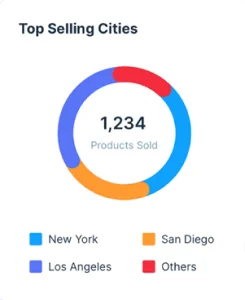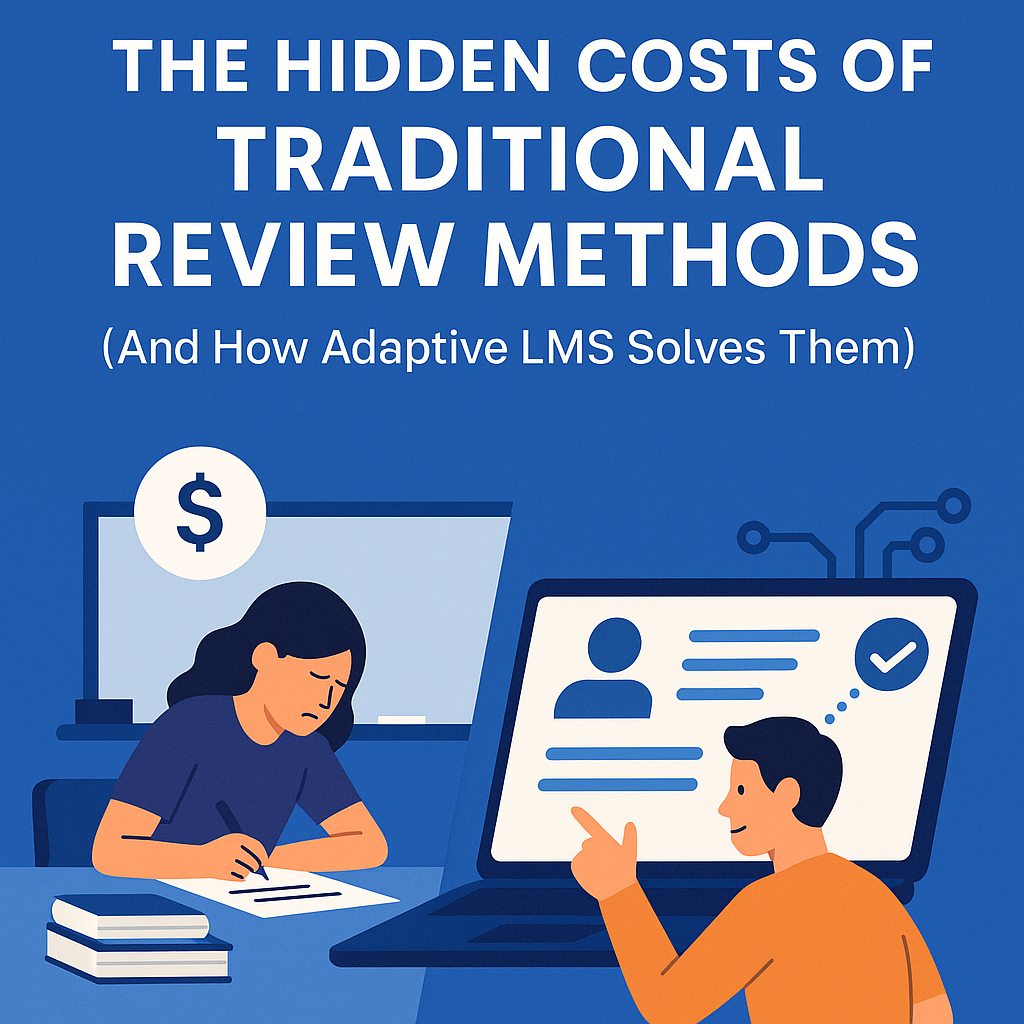The Hidden Costs of Traditional Review Methods (And How Adaptive LMS Solves Them)
We’ve all seen it before, especially when it comes to knowledge .
A cramped classroom. Whiteboard markers running dry. A stack of printed reviewers passed from one anxious student to the next.
It’s familiar. It’s predictable. But here’s the thing—it’s no longer effective at addressing knowledge gaps .
While traditional review methods have held their place for decades, the landscape of learning has evolved. And frankly, a lot of review centers are struggling to keep up. The old ways? They aren’t just inefficient. They’re quietly expensive, both in time and in outcomes.
That’s where adaptive learning platforms, like PathBuilder, come in to enhance personalized learning . And not just as a modern alternative. But as a genuinely smarter, more human-centered way to help learners succeed.
Let’s break it down.
TL;DR
Traditional review methods often fall short in addressing individual learning gaps and can be inefficient for review centers managing large cohorts. An adaptive LMS personalizes content in real time, helping students learn at their own pace, providing immediate feedback, and offering actionable insights for instructors. Platforms like PathBuilder improve engagement, boost test scores, and support better outcomes by aligning the learning experience with each student’s unique needs.
| Traditional Approach | Adaptive LMS Solution | |
|---|---|---|
| Problem | One-size-fits-all content, fixed pacing, minimal feedback | Real-time personalization, flexible learning paths, ongoing feedback |
| Instruction Quality | Instructors manually monitor and support students | AI tracks progress, flags gaps, and provides insights to instructors |
| Learner Engagement | Generic practice, static materials, high dropout risk | Gamified tasks, visible progress, purpose-driven content |
| Performance Outcomes | Inconsistent test results, delayed intervention | Higher test scores, early support, tailored remediation |
| Scalability | Hard to personalize for large cohorts | Easily adapts to individual needs at scale |
| Implementation | Requires complete LMS replacement | Integrates with existing systems, starts small and scales |
| Future Readiness | Limited tech adoption, little innovation | Built for AI, VR/AR, and future learning needs |
Introduction to adaptive learning
Adaptive learning is a system that personalizes education in real time, providing real time feedback . It adjusts content, pacing, and even difficulty based on how each learner performs—moment to moment.
Picture this: one student is confidently flying through biochemistry modules, while another hits a wall in pharmacology. Instead of dragging both through the same one-size-fits-all review, an adaptive learning system responds. It slows things down when confusion shows up. It skips the stuff that’s already mastered. It shapes a learning journey that feels; well, like it was designed just for that learner.
And this isn’t theoretical. We’re not talking about some vague “future of learning.” Adaptive learning is already here. It’s powered by real-time data, AI algorithms, and behavior tracking that most people don’t even notice happening under the hood.
But the impact? That’s hard to miss.
Especially in high-pressure spaces like licensure prep, the difference between “keep up or get left behind” and “grow at your own pace” can determine outcomes. And frankly, students notice. They feel the difference when a system adapts to them instead of expecting them to adapt to it.
It’s a shift from mass teaching to truly responsive and interactive learning—and once you’ve seen it in action, going back feels almost unthinkable.
Benefits of adaptive learning
Let’s be honest. Personalized education isn’t exactly a groundbreaking idea. Any great teacher, even without fancy tools, tries to adapt to each student’s needs. They always have.
But what adaptive learning does with adaptive lms for review centers is make that kind of individual attention actually scalable. It takes that quiet, one-on-one magic and builds it into the system itself, so it doesn’t depend on luck or bandwidth or heroic effort.
And for review centers? Where one instructor might be juggling 30, 50, even 100 students? That’s not just helpful. It’s transformative.
Here’s what that looks like in practice:
- Students learn at their own pace. No shame in needing more time. No boredom for those ready to move on.
- Struggles don’t slip through the cracks. The system spots weak points and gently steers learners toward reinforcement.
- Confidence builds naturally. When learners see progress, even in small bursts, motivation follows.
- Teachers gain clarity. Less time guessing who’s behind and more time offering real support where it counts.
And maybe the most underrated benefit? It makes learning feel… fairer.
No more being stuck in a lesson that doesn’t match your level. No more feeling like you’re failing because the system never flexes. With adaptive learning, education starts to feel like it’s finally working with the student, not against them.
Adaptive learning platforms in action
A strong adaptive platform doesn’t just personalize content—it pays attention.
It watches how learners interact. Every click, pause, skipped question, and aced quiz adds to a constantly evolving profile. Not to spy, of course, but to learn. And to respond.
It’s less like a textbook, more like a tutor that actually remembers what works (and what doesn’t) for each student.
Here’s what that means in practice:
- Lessons adjust in real time. If a student struggles with a concept, the system pivots. No delay.
- Feedback is immediate. Not next week. Not after grading day. Learners know right away where they stand.
- Everything connects. Whether you’re using an LMS, CRM, or another learning tool, integration keeps it seamless.
- It works on mobile. Because let’s be honest, students are more likely to review from their phones than from a desktop.
- Managers get visibility. With dashboards that show patterns, problem areas, and progress across the cohort.
We’ve seen this kind of platform succeed in all kinds of spaces using analytics tools : corporate upskilling, language schools, even hospital training programs.
But review centers? They stand to gain the most.
Why? Because in this space, results aren’t optional. Pass rates aren’t just a goal, they’re the metric that keeps doors open and students enrolling. So when a platform can move the needle, even by a few percentage points.
And in a crowded education market, that edge matters more than ever.
Learning experiences: personalized, relevant, motivating
Think back to your own school days. Ever find yourself sitting in a class, nodding along to a topic you already understood inside out, quietly hoping the teacher would just move on? Or maybe the opposite: the lesson moved too fast, and somewhere between slide three and five, you got left behind.
Both experiences are frustrating. And oddly common.
That’s what adaptive learning is designed to fix.
Instead of pushing everyone through the same content at the same speed, adaptive systems build learning around the individual. Which, when you think about it, is how learning should work in the first place.
Here’s what that means in the context of a review center:
- Each student gets a custom learning roadmap. Built around their strengths, gaps, and exam goals.
- Struggling learners get extra support—quietly. Without the shame or spotlight of falling behind.
- Advanced students aren’t held back. They stay challenged, which keeps motivation high.
- And everyone feels seen. Like the program was built for them, not just the average learner.
No smoke and mirrors. No gimmicks. Just smart, responsive design that respects the way people actually learn.
And when students feel seen, supported, and respected… they tend to stick with it.
Adaptive learning in higher education
In colleges and advanced learning programs, adaptive platforms aren’t just emerging. They’re quietly becoming standard.
And for good reason.
They offer something traditional methods can’t: ai powered real-time awareness. Instructors don’t have to wait until midterms to see who’s slipping through the cracks. The system surfaces those gaps as they happen, while there’s still time to fix them.
But perhaps the most transformative part? The data.
Not just pass/fail outcomes. Not just attendance logs. But deep, actionable insight.
Administrators can finally ask better questions: Which topics are consistently tripping students up? Which teaching methods are actually working? Is that new module helping—or hurting—performance?
And they don’t have to guess. The platform tells them.
That kind of visibility just isn’t possible with static formats. No spreadsheet or printed quiz can reveal the nuance of how a student learns, struggles, or improves over time.
Adaptive platforms do. And in higher ed, where the stakes are high and the pressure is constant.
Implementation and integration: what it really takes
Switching systems can feel intimidating.
Some review centers hesitate because of the learning curve. Will the instructors get it quickly? What about the students? And what happens to all the materials already built into your current LMS?
These are fair questions. No one wants to overhaul their entire workflow just to “try something new.”
The good news? You don’t have to.
Most modern adaptive learning platforms; PathBuilder included, are designed to fit in, not take over. They’re built to integrate with existing systems or run alongside them. In fact, many review centers start by using the platform in one subject area or course track before scaling up.
Here’s what a typical software rollout actually involves:
- Clarity around goals. Are you trying to improve pass rates? Engagement? Retention? All three?
- Basic training sessions. Usually short, focused, and practical. No weeks-long onboarding needed.
- Support that speaks your language. The provider should understand your context, your learners, your constraints.
And once it’s live?
You start seeing patterns. Struggling students surface earlier. Instructors stop guessing. Data starts making sense. And momentum builds. Because the results start speaking louder than the fears that held you back.
The future of adaptive learning
The future of adaptive learning isn’t a vague vision anymore, it’s already unfolding.
At PathBuilder, we’re not just watching the shift happen. We’re building toward it.
Immersive technologies like VR and AR are no longer distant possibilities. Imagine this training : a nursing student rehearsing emergency procedures inside a fully interactive simulation that adapts to their decisions. Or a review candidate walking through a digital lab where every mistake triggers a tailored correction. Not after the fact, but in the moment.
This is where adaptive learning is headed. And it’s not just for novelty. It’s for deeper engagement, better recall, and more real-world readiness.
Then there’s AI, especially generative AI. PathBuilder is already moving toward more natural, conversational guidance. Instead of being boxed into multiple-choice logic, learners will get smart, contextual feedback that feels more like talking to a mentor than a machine.
More flexibility. More relevance. More human-centered design.
That’s the direction PathBuilder is pushing. Because the truth is, the technology isn’t the barrier anymore, but development is . The real challenge? Making sure review centers are willing to evolve alongside it.
Those that do won’t just modernize their tools. They’ll future-proof their entire approach to learning.
Choosing the right platform
Plenty of platforms say they offer adaptive learning.
But “adaptive” can mean a lot of things, and not every solution is built for the high-pressure, outcome-driven world of review centers.
If you’re choosing a platform to support serious learners (the kind prepping for licensure, not just passing time), you’ll want more than just a flashy interface or auto-graded quizzes.
Here’s what really matters:
- Personalization that goes deep. Not just “easy/medium/hard,” but content that truly adapts to individual progress, strengths, and gaps.
- Real-time tracking. Progress should be visible. Not just at the end of the course, but every step along the way.
- Mobile-first design. Let’s be honest: most learners are studying between commutes, shifts, or mealtimes, on their phones.
- Flexibility in delivery. A mix of self-paced and instructor-led learning lets centers tailor programs around what works.
- Dashboards with insight, not just data. Directors and instructors need to understand patterns, not drown in spreadsheets.
- Built-in engagement tools. Gamification isn’t a gimmick. It keeps momentum going, especially when prep fatigue kicks in.
And perhaps most importantly: choose a platform designed for your learners.
Something built for K–12 might look slick. But fall short under the weight of professional exam prep. PathBuilder was built specifically with personalized learning paths for review centers in mind. Because you’re not just running classes. You’re shaping futures.
Better performance through adaptive learning
For review centers using platforms like PathBuilder, the gains have been clear, measurable, and often surprisingly fast.
We’ve seen:
- Test scores rise—sometimes by double digits in just one exam cycle
- Student satisfaction climb, especially among previously disengaged learners
- Dropout rates fall, as struggling students stay supported instead of slipping away
- Instructor time used more strategically, focused where it matters most
But if there’s one result that cuts deeper than metrics, it’s this:
Learners start believing in themselves again.
When the content shifts to fit them. Their pace, their gaps, their goals, they stop feeling like they’re trying to catch up to a system that was never built for them in the first place.
And that changes everything.
Instead of being pulled through the material, they begin to lead their own learning. With confidence. With purpose. With momentum.
And for a review center, that shift (from passive to active, from confused to motivated) isn’t just a nice-to-have.
It’s the very thing that turns average outcomes into exceptional ones.
Learner engagement strategies that actually work
Keeping learners motivated over weeks (or even months) of review prep isn’t easy.
You can’t just crank up the volume on lectures or swap in new slide designs and hope for the best. Engagement doesn’t come from flash. It comes from relevance.
That’s why adaptive platforms like PathBuilder are so effective. They don’t try to entertain learners. They involve them.
Here’s how:
- Progress is visible. Students can actually see how far they’ve come, and how far they have to go.
- Practice feels purposeful. Every quiz, every module feels connected to their goals, not just thrown in.
- Challenges feel achievable. Gamified tasks and clear milestones keep momentum alive without overwhelming.
- Pacing feels fair. Learners set their rhythm, which reduces burnout and builds consistency.
- Feedback is timely and useful. Not just a score, but real guidance, when it matters most.
When students feel like the system is working with them; not against them, they stop zoning out.
And suddenly, the learning process becomes something they’re actively shaping. Not something that’s just happening to them.
That shift (from passive participant to active learner) helps optimize learning time and is the real engine behind long-term engagement.
Key features to consider
Let’s finish with something practical.
If you’re evaluating adaptive learning platforms for your review center, here’s what to look for:
- True AI-driven personalization: The platform should respond to how each learner thinks, not just how they score.
- Instructor dashboards with real insight: Data that’s digestible, not just dumped.
- Continuous formative assessments: So students and instructors know where they stand, at all times.
- Mobile and desktop access: Because real life doesn’t happen at a desk.
- Gamification that motivates, not distracts: Points, streaks, challenges, simple things that keep momentum going.
- Smart content adaptation: Based on skill gaps, pace, and prior performance, not just predefined levels.
- Flexible integration: Whether it’s plugging into your LMS or syncing with other systems, it should fit in, not force a rebuild.
If a platform can’t offer most (or ideally all) of that?
Then it’s probably not adaptive. It’s just another digital classroom in disguise.
And that’s not what your learners need. Or deserve.
It’s time to move forward—with your learners
Traditional review methods had their moment. They laid the groundwork. They got us here.
But today’s learners need more than structure. They need strategy. Personalization. Flexibility. Real support that meets them where they are, not where the syllabus says they should be.
Clinging to one-size-fits-all systems doesn’t just slow your students down. It holds your entire review center back. From better results, better satisfaction, and better outcomes.
An adaptive LMS like PathBuilder changes that.
It doesn’t just digitize your materials. It transforms the entire learning experience, into something smarter, more human, and far more effective.
Because every learner deserves a personalized learning experiences plan that adapts to them.
And every review center deserves a platform built for the way education should work now. Not the way it used to.
Ready to make the shift?
Start with a free walkthrough or book a personalized consult. See how PathBuilder can help you deliver learning that actually moves the needle, for every student you serve.


















The PathBuilder team is a dynamic group of dedicated professionals passionate about transforming education through adaptive learning technology. With expertise spanning curriculum design, AI-driven personalization, and platform development, the team works tirelessly to create unique learning pathways tailored to every student’s needs. Their commitment to educational innovation and student success drives PathBuilder’s mission to redefine how people learn and grow in a rapidly changing world.